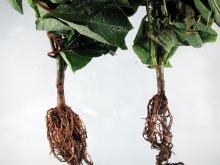Cause Rhizoctonia solani, a soilborne fungus favored by high greenhouse (soil) temperatures. Root rot increases as soil temperatures between 62°F and 79°F. It generally causes loss during rooting and can enter cuttings through wounds. Wounds from salt accumulation at the soil line also can be entry points. It survives in the soil as sclerotia or as mycelium colonizing bits of organic matter. The fungus can form knots of mycelium that develop into sclerotia. These are released into the soil as the plant debris decomposes.
Symptoms A brown dry canker on the cutting's stem at the infection site. The canker enlarges up the stem and down into roots. Cuttings wilt and die. Less often, roots rot in older plants, causing lower leaves to yellow, wilt, and roll. The plant is stunted and finally dies. Lesions usually start at the soil line, and infected roots usually are brown. Brown-cankered crown rots can occur without root rot. Longitudinal cracking and a dry appearance of the rotted crown tissue often develop on older plants.
Cultural control Clean growing surfaces, clean water, and handling practices along with soilless media are all helpful.
- Grow plants at 69°F to 76°F and at a recommended pH range of 5.8 to 6.2.
- Plant pathogen-free cuttings. Inspect carefully before planting.
- Use soilless potting mix or steam-treated soil and rooting media. Steam 30 min. at 180°F. Keep field soil out of contact with clean media.
- Use new pots, trays, or treat any reused items with a disinfectant, use steam, or solarization techniques (such as with anti-condensation film) to clean them.
- Avoid wounding cuttings before or during planting.
- Do not over-fertilize or let plants dry out. Fertilize less as plants mature. Monitor soluble salt concentrations regularly keeping the EC below 2.0 early and 1.2 later.
- Remove and destroy any diseased plants before planting or during the growing cycle. Do not contaminate adjacent pots while removing dead plants.
- Control fungus gnats especially during rooting.
Chemical control Cultural controls reduce or eliminate the need for chemical drenches. If used, treatments must be made before infection occurs right after sticking.
- Affirm WDG at 0.25 to 0.5 lb/100 gal water. Group 19 fungicide. 4-hr reentry.
- Banrot 40 WP at 6 to 12 oz/100 gal water. Avoid using the granular formulation. Group 1 + 14 fungicide. 12-hr reentry.
- Broadform at 2 to 8 fl oz/100 gal water. Group 7 + 11 fungicide. 12-hr reentry.
- Chipco 26019 FLO at 13 fl oz/100 gal water. Use 1 to 2 pints of this solution per sq ft. Group 2 fungicide. 12-hr reentry.
- Empress at 1 to 3 fl oz/100 gal water can be used for cuttings or seedlings. Group 11 fungicide. 12-hr reentry.
- Heritage at 1 to 4 oz/100 gal water. Group 11 fungicide. 4-hr reentry.
- Medallion WDG at 1 to 2 oz/100 gal water. Using with oils or adjuvants may damage plant. Group 12 fungicide. 12-hr reentry.
- Pageant at 12 to 18 oz/100 gal water used as drench. Do not use with organosilicone-based adjuvants. Group 7 + 11 fungicide. 12-hr reentry.
- ProStar 70 WG at 3 to 12 oz/100 gal water. Group 7 fungicide. 12-hr reentry.
- Spirato GHN at 2 to 4 fl oz/100 gal water. Use with oils or adjuvants may cause plant damage. Group 12 fungicide. 12-hr reentry.
- Terraguard SC at 4 to 8 fl oz/100 gal water. Group 3 fungicide. 12-hr reentry.
- Thiophanate-methyl-based products. Inconsistent efficacy. Group 1 fungicides. 12-hr reentry.
- Cleary's 3336 EG at 8 to 16 oz/100 gal water.
- OHP 6672 4.5 F at 7.5 to 20 fl oz/100 gal water.
Reference Benson, D.M. 1991. Control of rhizoctonia stem rot of poinsettia during propagation with fungicides that prevent colonization of rooting cubes by Rhizoctonia solani. Plant Disease 75:394-398.

